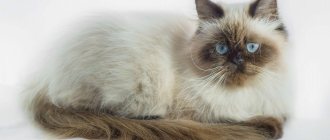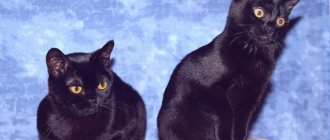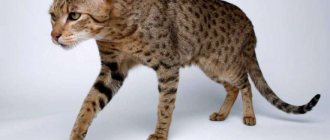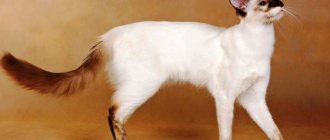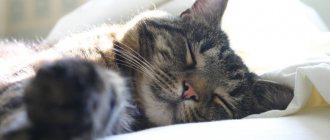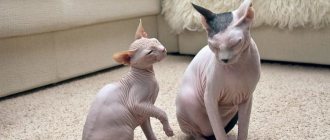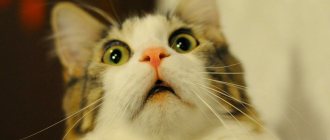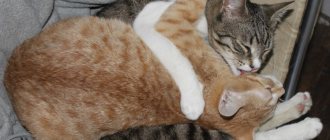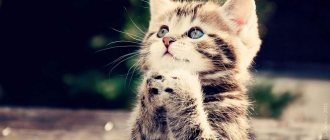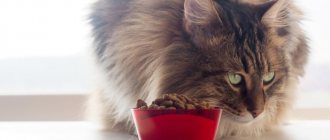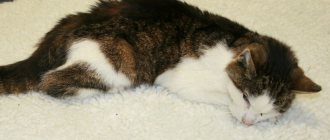How often have you met Persian and Siamese cats? Now imagine what their direct descendant might look like - himalayan cat
, taking only the best from each line. Colors and long fur are another reason to meet this gentle and kind beauty. A lot of effort was put into bringing such a fluffy miracle into the world, so such an animal is a treasure in itself.
Siamese cat
- Height: 20-25 cm
- Body weight: 2.7-6.3 kg
- Lifespan: 15-20 years
- Temperament: smart, sociable, courageous and affectionate
The breed originated in Thailand (formerly called Siam) and was highly valued in the imperial court. Siamese cats are considered one of the oldest breeds in the world. They have a lean but muscular build, smooth color-point coats and expressive blue eyes.
Due to their short, low-shedding coat, Siamese cats are hypoallergenic , making them ideal for allergy sufferers.
These graceful cats are family-oriented and crave constant companionship. The breed is extremely vocal, territorial, interactive, playful and very intelligent.
History of the origin of the breed
Attempts to cross Siamese cats with Persians began in 1924 in Sweden and America. A more serious attempt was made by American breeders in 1931. They crossed a male black Persian and a female Siamese.
The experiment resulted in the birth of black kittens, more reminiscent of the modern Balinese than the Himalayan breed. The first mixed-breed kitten born was named Newton Debutant. At this point the crossing stalled.
Canadian breeder Ben Boret followed a similar experimental path in the 1950s. He achieved a long-haired beauty color-point cat - characteristic features of the Himalayan breed. Next, Margarita Goforth took up the crossing. Thanks to her, in 1957 the breed was recognized in the CFA association, but in 1984 it was merged with the Persian. In 1979 the breed received recognition from the TICA association.
Independent crossing took place in 1955 in Great Britain. There the breed was called “long-haired color-point”.
Description of the Himalayan cat
The Himalayan cat inherited a specific color from the Siamese breed: light fur turns into darker tones on the protruding parts of the body: ears, muzzle, paws, tail. This type of color is called “color point”, it is a feature of the Himalayans. The Persians got long hair and a massive body. It should be noted that Himalayan kittens do not immediately receive their breed color.
Breed standards
The characteristics of the breed include the following basic standards:
Japanese Bobtail
- Height: 20-23 cm
- Body weight: 2.7-4.5 kg
- Lifespan: 9-15 years
- Temperament: Active, sociable, playful, intelligent, courageous, affectionate and territorial
As you can guess, Japanese Bobtails come from the Land of the Rising Sun. Their ceramic figurines are popular all over the world, and in Japan itself, maneki-neko figurines are considered a talisman of good luck.
These cute, funny pets are relatively rare, so they typically cost between $600 and $1,600 .
A distinctive physical feature of the Japanese Bobtail is its short, rabbit-like tail. These pets are sociable, playful, loyal, intelligent and active. The energetic Japanese Bobtails are especially good with children. They love to be the center of attention, adore human care and love to communicate.
Chinese Li Hua
- Height: 30-35 cm
- Body weight: 4.1-5.5 kg
- Lifespan: 12-15 years
- Temperament: Intelligent, independent, alert, active and friendly
The Chinese Li Hua, also known as the "dragon Li" and the "fox flower cat", is believed to have thrived in the wild for hundreds of years before being eventually domesticated. Today, she is admired for her unwavering devotion to her owners and loyalty to children.
The Chinese Li Hua was adopted by the Cat Fanciers Association only in February 2010.
This active cat breed can be taught tricks. The Chinese Li Hua is friendly to cats and dogs. She loves interactive toys and appreciates human attention. If you treat her politely and with respect, she will respond with affection and devotion.
Burmese cat
- Height: 25-31 cm
- Body weight: 2.8-6.3 kg
- Lifespan: 9-13 years
- Temperament: active, people-oriented, friendly, sociable, intelligent, affectionate and demanding
The ancestors of Burmese cats come from Burma (now Myanmar). There are two varieties: American and European. The European species (sometimes called the "traditional") is more slender, with a wedge-shaped head, small pointed ears, and almond-shaped eyes. Meanwhile, the American (or "modern") Burmese is noticeably stockier, with a wider head, ears with a wider base, and eyes that are much rounder and more expressive.
Most Burmese cats trust strangers and make friends easily . If you often have guests over, this kitty's outstanding social skills are sure to make a splash!
These magnificent cats are direct descendants of Siamese cats, which explains their chatty nature; however, their voices are softer and less demanding. Like their cousins, Burmese cats are playful, energetic, and very intelligent. They are very sociable and love to cuddle. In fact, these kittens are so affectionate that they are called the “ideal companion cats .
Character
Siamese cats are quite capricious and demanding, they need attention and communication. They can actively use their vocal cords, and with the help of this they communicate with the owner. By changing their tone, they inform their owner about everything that worries and interests them.
Siamese cats are very attached to family members and can be jealous of other pets.
They are also distinguished by their intelligence and literacy.
Singapura cat
- Height: 16-21 cm
- Body weight: 1.8-3.7 kg
- Lifespan: 11-15 years
- Temperament: energetic, outgoing, affectionate, friendly and curious
In their native Singapore, they are elevated to the status of a national treasure. There, Singapura cats are nicknamed “Kutsinta,” which translates to “love cat” or “the one I love.” Geneticists suggest that this breed shares ancestry with Siamese, Abyssinian and Burmese cats.
The Singapore cat is included in the Guinness Book of Records as the smallest breed of domestic cat.
Their short coat is usually ivory in color with dark brown markings. They are sociable and interactive cats that remain curious and playful long after they reach adulthood. Singapura cats are also incredibly assertive and talkative.
Character traits and habits of Himalayan cats
Himalayan kittens are very playful, active and curious; you won’t get bored with him. With age, they become more imposing, calm, balanced and sometimes retire. A distinctive characteristic of the Himalayan cat is its strong attachment to its owner; it constantly requires his attention. They treat children very well. But they cannot stand noisy companies. Representatives of this breed are considered one of the smartest in the cat world; take care of their upbringing from childhood.
Himalayan cats are neat people, they need cleanliness and order; carefully monitor their sleeping area and toilet. And be sure to constantly care for their fur.
Korat
- Height: 25-36 cm
- Body weight: 2.7-4.6 kg
- Lifespan: 10-15 years
- Temperament: Loyal, energetic, playful and quiet
Korats are another breed native to Thailand. They are distinguished by their silvery blue fur, stunning emerald green eyes and muscular build. Despite their relationship with Siamese cats, these pets are very calm, do not like sharp sounds and have a habit of moving carefully and timidly.
Korats were once given to newlyweds in the hope of bringing good luck to their home and family.
Korats are gentle and affectionate cats that enjoy human company. They love attention and enjoy being involved in all aspects of the household: whether you're cooking dinner, cleaning the room, folding laundry, or getting ready to watch your favorite show, the Korat will be on hand to offer advice and lend a helping paw.
Unlike many other cat breeds, Korats are easy to train. Playful and friendly, Korats tend to get along well with everyone, including children and other cats and dogs. And Korats shed less than other cats.
Care and maintenance
Siamese feel most comfortable in warm climates because they are not cold-resistant. Keeping, accordingly, is preferable at home, with short walks under human supervision.
For a Siamese, you need to purchase toys to train your intellect and muscles.
Siamese cats are often not allowed to be bathed; they are quite clean and take care of themselves. 1-2 times a week you need to comb them with a special comb-comb. The Siamese cat has weak teeth; they require increased attention and care; it is recommended to clean them with toothpaste for animals and a special brush that is placed on the owner’s finger.
It is best to give preference in nutrition to ready-made food of the “holistic” and “super-premium” classes, and there should also be constant access to water. If you are a supporter of natural nutrition, then your Siamese’s diet should include: raw beef, boiled chicken breast, fermented milk products and meat-based baby food. It is strictly not recommended to feed your Siamese cat pork and milk!
Oriental shorthair cat
- Height: 23-28 cm
- Body weight: 3.6-4.6 kg
- Lifespan: 12-15 years
- Temperament: Curious, outgoing, affectionate, intelligent, loyal and extroverted
Oriental Shorthair cats were created by crossing Siamese cats with other domestic cat breeds. The goal was to maintain the sleek and slender shape of Siamese cats while offering a much wider selection of coat colors and patterns. Today there are approximately 300 color combinations .
Orientals are easily recognized by their slender and muscular build, long neck, angular face with almond-shaped eyes and large ears.
Although their appearance is unusual and many are unfamiliar with these felines, Oriental Shorthairs are not as rare as other exotic cat breeds such as the Khoa Mani or Japanese Bobtail.
These cats are famous for their good-natured, sociable, inquisitive and playful nature. Orientals love to be around people and furry friends. They are always talkative and make an unusual cry, similar to a horn. They meow when they want something or want to know what you are doing and where you are.
Description of the Himalayan cat
Today, many cat organizations have come to a consensus on the standard. The difference between the Persian and Himalayan cat breeds is mainly in the length of the coat and its color variant.
According to TICA, a Himalayan beauty should look like this:
- Head
round and somewhat massive, smooth in shape.
With general proportionality to body size, the head is either large or medium in size. The jaws are wide, strong with a clear, regular bite. The chin looks strong and goes well with full, prominent cheeks. The muzzle of the Himalayan cat
is flattened in front and very wide and short; - Ears
the animals are small and set very wide, the tips of the ears are rounded;
- Eyes
very large and round, set wide and somewhat convex. The color must be in strict accordance with the standard - any variations of blue;
- Nose
equal in length and width, nostrils strongly open. If you examine the cat in profile, the nose will be level with the forehead and chin;
- Body
clearly recognized as a cobby type. The muscles are well developed. The abdomen is rounded on all sides, often large in size. The neck is short, massive, the chest is low;
- Himalayan cat paws
look short and straight. The bone is large. The pads of the paws are round and impressive;
- Tail
straight and in perfect accordance with the length of the body. Characterized by a very soft, fluffy, necessarily pigmented tail;
- Himalayan cat fur
very voluminous. Large volume is created due to the thick undercoat. Another characteristic feature of the breed is the fluffy collar. The coat is long on all parts of the body;
- Color
resembles a Siamese. The pigment for which the “Himalayan” gene is responsible appears on the face, paws, ears and tail. On such protruding areas of the body, variations in point color appear due to mutations of other genes. The most common color of Himalayan cats is seal point. The most rare are points of chocolate and lilac shades.
The appearance of the imposing pets is very impressive due to the combination of long fluffy hair and a somewhat arrogant expression of the muzzle, reminiscent of the Persians.
Turkish van
- Height: 25.4-35.6 cm
- Body weight: 4.5-9 kg
- Lifespan: 12-17 years
- Temperament: sociable, playful, active and intelligent
The Turkish Van originated in the area of the mountain Lake Van and is believed to have flourished away from human civilization for many centuries. These cats have a completely white body with multi-colored spots on the head and usually a solid tail of an identical shade. Surprisingly, this is not a white cat with colored spots, but on the contrary: the Turkish Van has one large white “spot” covering the entire body.
These felines are called "swimming cats" and love water and have waterproof coats. The Turkish Van will be happy to take part in water battles, play in the sink with the tap running, or simply enjoy a bath.
They have a slightly wedge-shaped head, medium-sized ears, and round eyes that are amber, blue, or a heterochromatic combination of both. Turkish Vans are incredibly intelligent, easy to train animals. Although these cats are affectionate towards their family members, they generally do not like hugs . Turkish Vans can lie next to you and will happily allow you to pet them, but they will not give in to your hands, preferring to be next to you rather than in your hands or lap.
Keeping at home
Brushing and bathing
Himalayan cats have long and thick hair, so they require daily brushing to avoid the formation of tangles. For this correct procedure you will need three different combs. First with sparse teeth, then with frequent ones, and finish with a brush with natural bristles.
It is also advised to periodically bathe animals to wash away fatty deposits from the fur. Himalayan cats are calm about this procedure and even love it. And don’t forget to trim your nails once every 2-3 weeks.
ATTENTION! Himalayan cats experience stress in small, confined spaces.
Diet
Himalayan cats are unpretentious in food. But they are prone to obesity, so monitor portion sizes carefully.
Veterinarians recommend feeding cats premium food for long-haired cats. But you can also give them natural foods: lean meat, sea fish, dairy products, vegetables, eggs, cereals. Don't forget to add vitamins to your diet. Plant special grass, oats, and wheat for them.
ATTENTION! Eliminate salty, sweet, peppery, smoked, fried and fatty foods from your diet.
Give milk only to young cats, and cottage cheese, kefir, fermented baked milk, and yogurt are more suitable for an adult cat. It is necessary to feed them fruits; they love apples.
Turkish Angora
- Height: 23-35.5 cm
- Body weight: 3.7-6.8 kg
- Lifespan: 12-18 years
- Temperament: good-natured, sociable, playful and talkative
With its high intelligence and gorgeous white fur, it's easy to see why the Turkish Angora is a national treasure in its native country. For a time, these magnificent, intelligent, graceful cats were considered deaf and were so actively used in crossbreeding to create the Persian breed that they almost became extinct.
Turkish Angoras are descended from African wild cats. And this is the only domestic cat kept in Ankara zoos .
White fur is traditionally the most popular color of Turkish Angoras, but they can also be found in black, tan, brown and gray, as well as tabby, tortoiseshell and bi-color variations. The Turkish Angora is very intelligent. They are incredibly social cats who develop strong bonds with their family members. They happily accept other cats and dogs, and their naturally domineering nature quickly makes them dominant in the home menagerie.
Burmese cat
- Height: 20.3-28 cm
- Body weight: 4.5-5.9 kg
- Lifespan: 13-15 years
- Temperament: Even-tempered, affectionate, inquisitive and intelligent
This is an ideal choice for those looking for a cute and affectionate feline friend. The Burmese cat, also known as the sacred cat of Burma, is a large, long-haired breed with a heavy bone structure.
Like other color point cats, Burmese cats are white at birth . Coat color changes with age. They can take up to three years to reach their final coloration.
Burmese cats are playful, sociable and very jealous! If one of these cats chooses you as its owner, it will crave your affection and become jealous of other pets that steal your attention. They are also called “Velcro cats” .
Diseases of the breed
The Siamese breed, like any other, has a tendency to certain diseases:
- Strabismus.
- Calcivirosis is a disease of the upper respiratory tract.
- Allergic reaction.
- Amyloidosis is a pathological accumulation of protein in the kidneys, liver or pancreas, which leads to dysfunction of these organs, including their failure.
- Psychological discomfort.
- Achalasia of the esophagus.
- Adenocarcinoma is a tumor of the small intestine.
- Hyperesthesia is increased sensitivity of the hard tissues of teeth.
- Lungs' cancer.
Persian cat
- Height: 25.4-38 cm
- Body weight: 3.2-5.5 kg
- Lifespan: 10-15 years
- Temperament: Even-tempered, independent, flexible, sensitive and playful
Persian cats are famous for their grand appearance and long, thick, shiny fur. These cats are believed to have existed exclusively in Persia (now Iran) and were then brought to Europe and crossed with other cat breeds, giving rise to the modern Persian breed. They were especially revered by royalty, including Queen Victoria, and Persian cats soon became popular in many countries.
Persian cats are one of the most ancient breeds of domestic cats with a thousand-year history. It is also one of the fluffiest long-haired breeds.
These furry pets love to lounge around, especially when they reach adulthood; This may be why some people call them “ furniture with fur . Don't be fooled by this reputation, however; these cats show a playful streak, especially when their family is ready to join in the fun.
Khao-mani
- Height: 25.4-30.5 cm
- Body weight: 3.6-4.5 kg
- Lifespan: 10-12 years
- Temperament: sociable, affectionate and courageous
First mentioned in classical Thai literature as early as 1350, khao mani, meaning “white gem,” immediately gained popularity. These light-eyed cats were prized by Thai aristocrats, considered sacred and protected by the ruling class for centuries.
The Khao Mani is one of the most expensive cat breeds in the world with a price tag of around $7,000-$11,000 . These rare cats are said to bring good luck to their owners.
These cats are sociable, curious and completely devoted to their family. Energetic and quite intelligent, Kao Mani love interactive games and quickly get along with children and other playful pets.
Mekong Bobtail
- Height: 17.8-23 cm
- Body weight: 3.6-4.5 kg
- Lifespan: 15-18 years
- Temperament: Outgoing, friendly, curious and energetic
The Mekong Bobtail is a cat breed that shares ancestry with the Siamese cat. It was named after the Mekong River, which flows through China, Laos, Cambodia and Vietnam. However, it was in Russia that the breed developed further before it became known in other countries.
Although Mekong Bobtails are recognized as a breed in their own right by the World Cat Federation, they are still classified as an "experimental breed" by the International Cat Association and the Cat Fancier's Association.
The similarity between Mekong Bobtails and Siamese cats is very pronounced due to their pointed fur and piercing blue eyes. But there is no confusion when they stand up and the characteristic pom-pom tail !
The Mekong Bobtail is an intelligent and quick-witted pet. He enjoys any vigorous play that involves climbing or jumping, but has a gentle and affectionate disposition. Due to their sociable nature, Mekong Bobtails do not like to be left alone for long periods of time and require attention.
Types of colors
Kittens of the Himalayan breed do not have a distinct color. Their “color” seems more uniform than that of adult cats. The final coloring appears only at two or three years of age. The spots on the paws, tail and face come in different shades. There are Himalayan cats of the following colors:
- with cream spots on the fur;
- with lilac;
- with redheads;
- chocolate colors;
- gray;
- blue color.
Breed standards require the presence of a dark mask on a basic light background, not extending beyond the “face”. Sometimes the dark parts of the color have stripes or spots of a different shade. The most valuable are chocolate and lilac colors on a light background - cream or white.
Kurilian Bobtail
- Height: 25.4-35.6 cm
- Body weight: 3.6-5.5 kg
- Lifespan: 14-20 years
- Temperament: Playful, energetic, affectionate and friendly
The Kurilian Bobtail is native to Sakhalin Island and the Kuril Archipelago. This is a natural cat breed , meaning that it was created through natural selection and not through any human manipulation.
Kurilian Bobtails mature very slowly and reach full growth at about five years of age.
The active Kurilian Bobtail has a playful disposition and loves to hunt. This breed is also known for its ability to fish, and they have waterproof fur so they don't mind getting wet. Tiny pets such as hamsters and guinea pigs should be kept away from Kurilian Bobtails, who view all small creatures as potential prey. However, they usually get along well with other cats, dogs and children.
Raas
- Height: 29-36 cm
- Body weight: up to 6.8 kg
- Lifespan: 12-15 years
- Temperament: Playful, stubborn, energetic and independent
Raas is a breed of domestic cat that originated on the Indonesian island of Raas. Their physical characteristics are very similar to a wild jungle cat or leopard. These cats are larger than most other breeds. The raas has a square-shaped muzzle, a slightly pointed chin, erect ears, and dark green eyes.
There are many myths about them. One states that these felines have a sixth sense , and can only be kept by a certain group of people, such as clergy and community leaders. Another myth says that if a person decides to take a raas off the island, his luck will turn away.
Raas are energetic and playful, but seem to be afraid of humans and sometimes have difficulty adapting. However, it is quite possible to tame them, but you will have to be patient, since from time to time the Raas can be stubborn and grumpy.
Colors
The main color of the Himalayan cat is always white or cream, and the points, which are located on the face, tail and paws, can be of different shades. The most common colors are black, chocolate, brown, lilac, blue and red points. According to breed standards, the contrast mask on the muzzle should be dark in color and have clear contours that do not extend onto the neck and chest.
- Color point - a light-colored body with contrasting contours of a darker color;
- Links point - there is a bright mask on the muzzle, vertical stripes form the letter M on the forehead, there is a dark edging around the eyes, the inner surface of the tail and ears is lighter than the outer surface.
